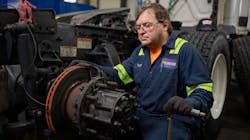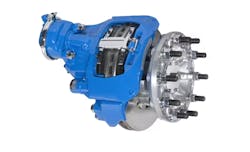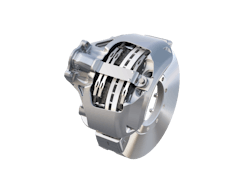Though a decade ago it was far from the case, nowadays, the likelihood for a technician to work on a newer truck with air disc brakes (ADBs) is about the same as one with drum brakes.
“Almost half of the builds for new equipment are for disc brakes today,” noted Mark Holley, director of marketing and customer solutions for wheel ends at Bendix Commercial Vehicle Systems. “With new trailers, it’s about 20%.”
Both types can provide some value to fleets, and when evaluating whether a drum or disc brake is the better overall fit, fleets should consider the benefits relative to the application they will be placed in. The total cost of ownership, including the maintenance and service, also factors into a brake’s longer-term ROI.
To help you calculate which is more suitable for your duty cycles and assets, we talked to leading brake experts about how service is done on each and what to look out for.
Service time is money
ADBs and drums have a few things in common, of course. Primarily, they both arrest vehicle movement, which takes a toll each time it happens.
“Friction and rotors will wear, as will friction and drums,” said Kevin Pfost, wheel end product specialist at Bendix.
But to discern the amount of wear, technicians must go about this in different ways.
“Visually and with a tool, a technician can measure friction and drum thickness,” Pfost said. “With a disc brake, we have a tool to measure rotor thickness. A technician can also measure the percentage of friction. So comparatively, disc brakes and drum brakes are the same in terms of visual inspections.”
Read more: Bad brakes, false logs were most common 2022 Roadcheck violations
The difference presents itself when the time comes to actually service the brakes.
Changing ADB pads takes roughly half the time of drum brakes, according to Joe Kay, director of engineering for Cummins-Meritor, a global power technology company whose products include disc and s-cam drum brakes.
Drum brakes not only require additional time, but oftentimes more effort.
“With disc brakes, you don’t have to pull off a heavy drum in order to change the friction,” Pfost explained. “With disc brakes, you’re only pulling wheels off.”
Furthermore, with a drum brake system, the technician is nowhere near done after removing the drum. There are brake shoes to deal with, which Pfost said can be a challenge in their own right. After that, the cam head should be cleaned up and inspected for wear or damage.
“You should really use a dial indicator to measure bushing wear on the cam head,” Pfost added. “If it’s out of spec, there is even more to do. You might have to pull the slack adjuster off, pull the cams and bushings out and put new bushings back in. You might find that the clevis pin is seized into the slack adjuster. Now you have to spend time working that out. You don’t have to do any of this on a disc brake because everything is internal.”
To service a disc brake, the friction removal process simply involves a spring clip, pin, and pad-retaining bar. Then you just pull out the worn pads. Next, push the caliper all the way inward, inspect the guide pin boots to make sure they aren’t torn, ensure that the caliper can slide freely, and inspect the boots on the tappets (pistons) in the caliper. If everything checks out OK, clean the carrier, measure rotor thickness to ensure it is within spec, and drop the new pads in.
“A technician can typically do all of that within 15 minutes per wheel end,” Pfost said, adding that a thorough drum brake inspection can push upwards of an hour.
“There will always be a technician who says they can change out brake shoes in 10 minutes,” Pfost continued. “They probably can, but they haven’t done any measuring. If a drum brake job isn’t done properly, you can run into problems like adjustment issues and hang-ups later in the brake’s life.”
There are also more moving parts with a drum brake. Plus, those parts are exposed to the elements, which increases the opportunities for contamination and damage.
“With a disc brake, you just have a caliper, rotor, and hub,” Pfost said.
One potential issue with a disc brake is if the rotor becomes damaged. Pfost said replacing a rotor is more time-consuming than replacing a drum. The caliper carrier assembly must be removed, followed by the hub and rotor. The standard repair time is around 100 minutes.
“Premature failures will always have an adverse impact to any ROI,” Pfost said. “But over the long-term, a rotor’s life expectancy is longer than that of a drum, helping reduce the total cost of ownership. Fleets could use our Bendix ADB Value Calculator (valuebybendix.com) to see the directional difference.”
Tips to maximize lifecycle ROI
The best thing a fleet can do to maximize lifecycle ROI on their brakes is to stay on top of wear. This is especially the case with disc brakes where the ROI proposition hinges a lot on preserving the rotor.
According to Pfost, rotors are designed to last at least several hundred thousand miles in on-highway applications with properly scheduled maintenance.
“Inspection for premature pad and rotor wear and early detection of conditions such as cracking or discoloring are vital to ensuring the life of the rotor,” Pfost said. “Drums get changed with every friction/shoe replacement.”
He added genuine Bendix pads and rotors can provide “at least two or three pad lives per rotor.”
When inspecting the rotor, a technician should look for rust or corrosion which may indicate that the brake isn’t functioning properly. “Damage such as a rough surface or gouge on the rotor braking surface may indicate that the pad is fully worn and the metal back plate is contacting the rotor,” Cummins-Meritor’s Kay said.
With respect to pad wear, brake manufacturers are giving technicians some assistance. For instance, Cummins-Meritor’s EX+ air disc brakes feature a visual wear indicator that allows for easy wheels-on pad wear inspection.
Bendix offers pad-wear sensing technology for their disc brakes. End-of-life alerts are issued at 3.5mm, helping technicians schedule service before the friction wears out and the backing plates destroy the rotor. “Now we’re improving this technology through continuous-wear sensing that identifies the percentage of friction left, communicating in real-time through the vehicle’s telematics system,” Holley said.
When maintaining disc brakes, technicians should also keep an eye on the caliper. The caliper should move freely, about 1mm, when braking occurs.
“A technician can check this by grasping the caliper and moving it axially with the parking brake off,” Kay explained. “No movement may indicate that the caliper may have an issue and should be inspected further. Excessive movement in the axial direction may indicate that the internal adjuster is not keeping up with pad wear and should be inspected further. Excessive up and down movement may indicate slide pin or bushing wear.”
Another thing fleets can do is consider the environment a given vehicle is operating in.
“Working in wet, corrosive, or dirty environments will wear brakes faster,” Kay said. “A fleet maintenance department must keep good records and adjust to any changes as they happen.”
Adjusting to changes is really what maximizing brake lifecycle ROI is all about. Staying ahead of friction wear helps preserve other vital components. So, one of the questions a fleet must ask itself is, how much time and money will it cost to stay ahead?
About the Author

Gregg Wartgow
Gregg Wartgow is a freelancer who Fleet Maintenance has relied upon for many years, writing about virtually any trucking topic. He lives in Brodhead, Wisconsin.


